The August Historic Building Calendar
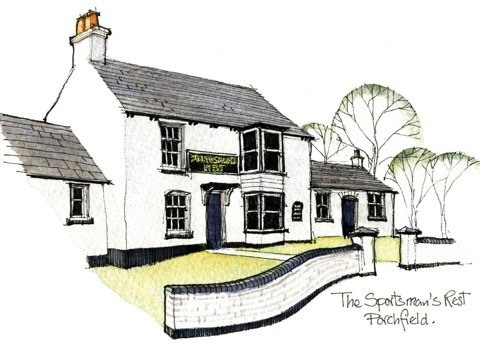
The Sportsman Rest, Isle of Wight
Contact Us Today to discuss your all Building matters entirely without obligation.
The August Historic Building Calendar
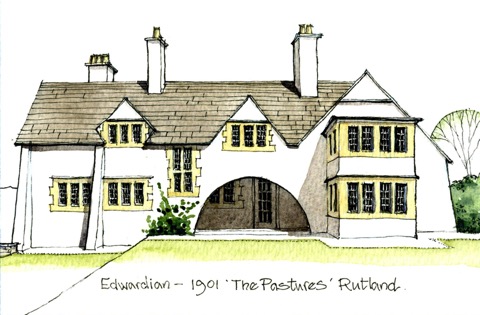
Edwardian – ‘The Pastures’, Rutland
The Pastures was designed by Charles Voysey and is now listed Grade II*. Voysey was not a very prolific architect and almost all his commissions were completed between 1890 and 1914. These mainly comprised a series of individual houses in locations across England; all in his trademark style of simple rendered walls with horizontal ranges of windows set in stone surrounds and subdivided by stone mullions, under roofs of slate or stone flags, with deep, overhanging eaves.
Whilst Voysey only completed a relatively small number of buildings, his work was widely published and influenced a generation of architects, including those responsible for the garden cities of Letchworth and Welwyn built in the early decades of the 20th century.
Tombleson Associates are not only Members of the Royal Institution of Chartered Surveyors, but also hold high academic qualifications in field of Historic Building Conservation.
Please Contact Us Today and we will be happy to discuss all your Historic Building matters entirely without obligation.
Understanding Building Defects
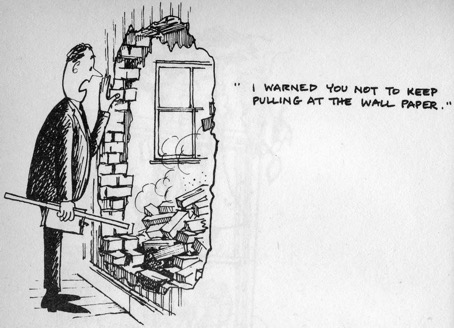
Understanding building defects on the Isle of Wight and Southern England is one of the most common challenges presented to Surveyors.
At Tombleson Associates, we understand that accurate diagnosis of a failure in building fabric or construction detail will lead to effective and appropriate repair strategies. For example, a crack in an external wall can be categorised with the BRE (Building Research Establishment) classification of damage based on crack width, yet still require judgment based on all influencing factors. Consideration of each building element (however minor) may provide valuable information. Addressing the ‘bigger picture’ and understanding the apparent defect as a whole is crucial.
Competency in Building pathology is the knowledge and experience of defective building fabric; and the subsequent impact upon any adjoining parts. Correct diagnosis is paramount when representing the RICS (Royal Institution of Chartered Surveyors) as Building Surveyors serving Hampshire, New Forest, Isle of Wight and West Sussex. For more information on your own building or one you may be interested in purchasing please Contact Us for a ‘no obligation’ discussion
The July Historic Building Calendar
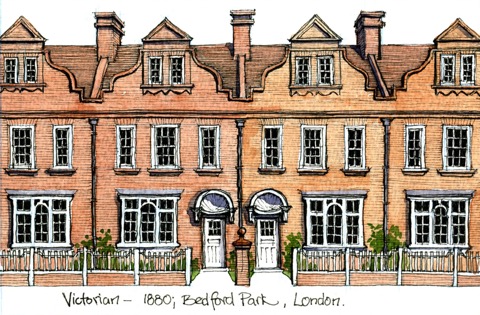
Victorian – Bedford Park, London - Click Image to Enlarge
Bedford Park is regarded as the prototype for later garden suburbs and was conceived by Jonathan Carr, who in 1875 bought 24 acres of land adjacent to the newly built Turnham Green station 30 minutes from the City. The well regarded Victorian architect Richard Norman Shaw was responsible for a number of house types at Bedford Park, and was succeeded by his pupil and protégé Edward J May. In 1880 May designed this terrace of four houses with their distinctive Dutch gables and shell-shaped porches. The terrace is today listed Grade II and Bedford Park is designated as a Conservation Area.
Expert surveyors at Tombleson Associates are not only Members of the Royal Institution of Chartered Surveyors, but also hold high academic qualifications in the field of Historic Building Conservation. We regularly examine and survey Victorain Buildings like Bedford Park in Hampshire, New Forest, Isle of Wight, West Sussex and Dorset.
Please Contact Us Today and we will be happy to discuss your Historic Building matters entirely without obligation.
The June Historic Building Calendar
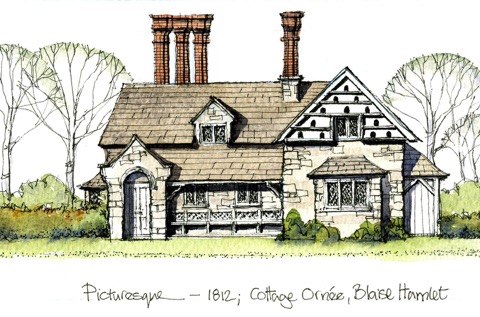
Picturesque – Cottage Ornée, Blaise Hamlet, Bristol - Click Image to Enlarge
The Picturesque Movement began in the latter part of the 18th century, and originally applied to landscape painting. By the Regency Period the term was applied to cottage ornée - deliberately contrived rustic cottages - and to Italianate or castellated country houses.
Blaise Hamlet was commissioned by the Quaker banker John Scandrett Harford to house his retired servants and is the work of John Nash and George Repton (son of Humphrey Repton). The hamlet consists of 9 differing cottages informally arranged around a central green. The cottages are built of stone; with roofs of stone flags, thatch or plain tiles and all have elaborate brick chimney stacks. All 9 are listed Grade I.
Tombleson Associates are not only Members of the Royal Institution of Chartered Surveyors, but also hold high academic qualifications in field of Historic Building Conservation.
Please Contact Us Today and we will be happy to discuss all your Historic Building matters entirely without obligation.
Glossary of Architectural Terms


Basic Glossary of Architectural Terms – Click Image to Enlarge
Above image will help to explain the basic Glossary of Architectural Terms.
Contact Us Today and we will be happy to discuss all your property matters.
The May Historic Building Calendar
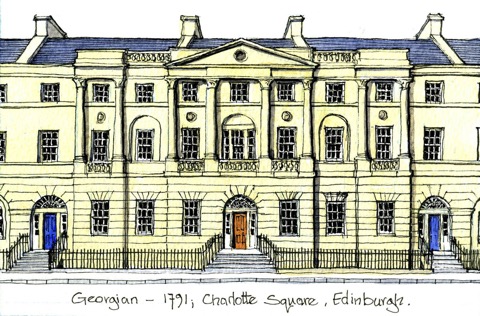
Georgian – Charlotte Square, Edinburgh - Click Image to Enlarge
The Georgian period witnessed the construction of a series of planned grand squares and terraces, providing elegant and peaceful homes away from the noise and grime of city centres. In London Cavendish Square was laid out in 1717, followed by Grosvenor Square (1720), Berkley Square (1739) and Adam’s Fitzroy Square in 1790. Away from the capital, Bath was laid out by John Wood and his son, beginning with Queen’s Square in 1729 and culminating with the Royal Crescent in 1775. Edinburgh New Town was planned by James Craig in 1767 and was built by a variety of architects; Robert Adam designed Charlotte Square in 1791, shortly before his death.
Surveyors at Tombleson Associates are not only Members of the Royal Institution of Chartered Surveyors, but also hold high academic qualifications in the field of Historic Building Conservation. We regularly survey Historic Georgian Period Buildings across the New Forest, Isle of Wight, Hampshire, West Sussex and Dorset.
Please Contact Us Today and we will be happy to discuss your Historic Building matters entirely without obligation.
The March Historic Building Calendar
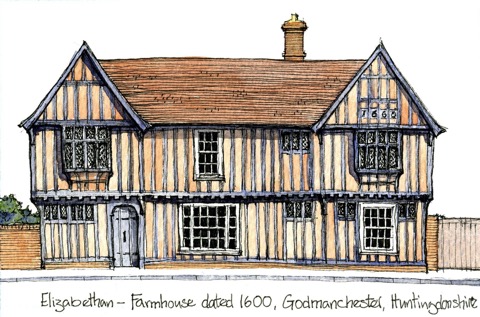
Farmhouse dated 1600, Godmanchester, Huntingdonshire - Click Image to Enlarge
This timber-framed farmhouse has a central hall range, incorporating a cross passage, flanked by two cross wings and with a continuously jettied first floor. The close studded exposed oak framing has wattle and daub infill panels and the date 1600 incorporated into one of the gables. The roof is of clay peg tiles. The farmhouse is listed Grade II*.
Contact Us Today and we will be happy to discuss your Historic Building matters entirely without obligation.
The April Historic Building Calendar
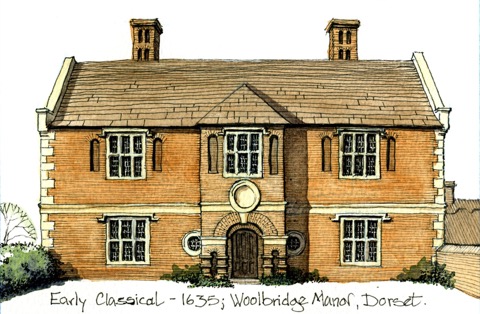
Early Classical – Woolbridge Manor, Dorset - Click Image to Enlarge
The Romans first introduced brickmaking into England, but the skill was lost during the Dark Ages and was gradually re-introduced from the Low Countries during the late medieval period, though initially its use was confined to high status buildings and it was only in the 17th century that use of brickwork moved down the social scale.
Woolbridge Manor is dated 1635 and is an example of the transition from medieval to classical design. There was no understanding of proportions in these early classical buildings, and classicism was restricted to symmetry on the principal elevations and the occasional use of classical motifs, such as the circular panel on the porch. Woolbridge Manor is listed Grade II*.
Expert surveyors at Tombleson Associates are not only Members of the Royal Institution of Chartered Surveyors, but also hold high academic qualifications in the field of Historic Building Conservation. We regularly examine and survey Historic Buildings like Woolbridge Manor in Dorset, Hampshire, New Forest, West Sussex and the Isle of Wight.
Please Contact Us Today and we will be happy to discuss your Historic Building matters entirely without obligation.
Why Engage A Independent Surveyor?
However Tombleson Associates is an Independent Firm of Specialist Surveyors serving Dorset, New Forest, Hampshire, Isle of Wight, West Sussex and East Sussex.
We act exclusively on your behalf providing a totally impartial report tailored to your specific needs. The details and advice given will allow you to reach a decision, uninfluenced by external considerations and conflicts of interest.
Some Points to Consider:
1. Is the Surveyor going to acting for you exclusively?
2. Do you wish to choose your own Surveyor?
3. Are you confident that your Surveyor is not influenced by external influences?
An Independent Surveyor will:
1. Agree the cost in advance.
2. Agree a timetable.
3. Discuss the contents of the report with you after the inspection.
4. Take into account alterations you may be contemplating & tailor report to your needs.
Please Contact Us Today for a True Independent Property Survey - We Always Offer the Initial Consultation Without Obligation or Cost.
Rising Damp – Does It Actually Exist?
If it exists at all, “Rising” damp describes the upward movement of moisture through building materials by capillary action: in masonry this will seldom achieve a rise exceeding a centimetre or two. Impermeable reservoirs at the base of walls (attributable to non-porous paint for example) may occur by the natural levelling of a water table. Horizontal “bridging”, gravity or condensation are the main causes of dampness in walls.
Expert surveyors at Tombleson Associates examine buildings in Dorset, Hampshire, Sussex and the Isle of Wight; we are often shocked at the misdiagnosis of dampness and the incorrect interpretation of visual evidence or moisture meter readings. We are constantly witness to the expensive and unnecessary destruction of old plaster in houses.
This month (and just in time) at a house in the New Forest we intervened in the proposed re-plastering work and traced the source of moisture to a tiny leak at the roof verge.
Unfortunately the phenomenon of “rising damp” has become endemic – propagated by surveyors in mortgage valuation reports and also in inappropriate remedial works by “specialist” damp treatment contractors obsessed with rising dampness. Most often the removal of rubble “bridges” in wall cavities, together with improvement in ground drainage and exterior ground levels will be the answer: if not, anti-condensation actions, and improved propensity for evaporation will solve the problem. Set a test! ...... does the surveyor know without hesitation, whether the damp meter is calibrated for wood or masonry and when the calibration was last re-set? Keep your money in your pocket unit you are absolutely sure of the correct advice!
